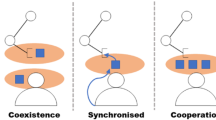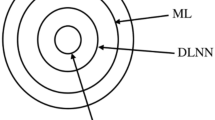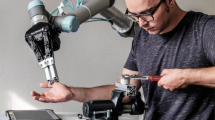Abstract
A visual and force feedback-based teleoperation scheme is proposed for cooperative tasks. The bilateral teleoperation system includes a haptic device, an overhead camera and a group of wheeled robots. The commands of formation and average velocities of the multiple robots are generated by the operator through the haptic device. The state of the multiple robots and the working environment is sent to the human operator. The received information contains the feedback force through the haptic device and visual information returned by a depth camera. The feedback force based on the difference between the desired and actual average velocities is presented. The wave variable method is employed in the bilateral teleoperation of multiple mobile robots with time delays. The effectiveness of the bilateral teleoperation system is demonstrated by experiments. The robots in the slave side are able to follow the commands from the master side to interact with the environments, including moving in different formations and pushing a box. The results show that the scheme enables the operator to manipulate a group of robots to complete cooperative tasks freely.















Similar content being viewed by others
References
Murray RM (2007) Recent research in cooperative control of multi-vehicle systems. ASME J Dyn Syst Meas Control 129(5):571–583
Espina MV, Grech R, Jager DD, Remagnino P et al (2011) Multi-robot teams for environmental monitoring. In: Kacprzyk J (ed) Innovations in defence support systems-3. Springer, Berlin, pp 183–209
Song G, Zhou Y, Ding F, Song A (2008) A mobile sensor network system for monitoring of unfriendly environments. Sensors 8(11):7259–7274
Kantor G, Singh S, Peterson R, Rus D, et al (2003) Distributed search and rescue with robot and sensor teams. In: Proceedings of field and service robotics, recent advances in reserch and applications, pp 529–538
Mondada F, Pettinaro GC, Guignard A, Kwee IW (2004) SWARM-BOT: a new distributed robotic concept. Auton Robot 17(2–3):193–221
Michael N, Fink J, Kumar V (2011) Cooperative manipulation and transportation with aerial robots. Auton Robot 30(1):73–86
Gerkey BP, Matarić MJ (2002) Pusher-watcher: an approach to fault-tolerant tightly-coupled robot coordination. In: Proceedings of IEEE international conference on robotics and automation, pp 464–469
Yang F, Liu S, Liu F (2011) Cooperative transport strategy for formation control of multiple mobile robots. J Zhejiang Univ Sci C 11(12):931–938
Hu Y, Wang L, Liang J, Wang T (2011) Cooperative box-pushing with multiple autonomous robotic fish in underwater environment. IET Control Theory Appl 5(17):2015–2022
Setter T, Kawashima H, Egerstedt M (2015) Team-level properties for haptic human–swarm interactions. In: Proceedings of IEEE American control conference, pp 453–458
Lee D, Martinez-Palafox O, Spong MW (2005) Bilateral teleoperation of multiple cooperative robots over delayed communication networks: application. In: Proceedings of IEEE international conference on robotics and automation, pp 366–371
Masone C, Giordano PR, Bulthoff HH, Franchi A (2014) Semi-autonomous trajectory generation for mobile robots with integral haptic shared control. In: Proceedings of IEEE international conference on robotics and automation, pp 6468–6475
Franchi A, Secchi C, Ryll M, Bülthoff HH, Giordano PR (2012) Shared control: balancing autonomy and human assistance with a group of quadrotor UAVs. IEEE Robot Autom Mag 19(3):57–68
Marton L, Szanto Z, Haller P, Sandor H et al (2014) Bilateral teleoperation of wheeled mobile robots working in common workspace. IAES Int J Robot Autom 3(1):62–74
Kim M, Lee D (2013) Toward tansparent virtual coupling for haptic interaction during contact tasks. In: Proceedings of IEEE world haptics conference, pp 163–168
Yoon SM, Kim WJ, Lee MC (2015) Design of bilateral control for force feedback in surgical robot. Int J Control Autom Syst 13(4):916–925
Chen Z, Liang B, Zhang T, Zhang B et al (2015) An adaptive force reaction scheme for bilateral teleoperation. Robotica 33(7):1471–1490
Farkhatdinov I, Ryu JH, Poduraev J (2009) A user study of command strategies for mobile robot teleoperation. Intell Serv Robot 2(2):95–104
Gioioso G, Mohammadi M, Franchi A, Prattichizzo D (2015) A force-based bilateral teleoperation framework for aerial robots in contact with the environment. In: Proceedings of IEEE international conference on robotics and automation, pp 318–324
Lin CW, Khong MH, Liu YC (2015) Experiments on human-in-the-loop coordination for multirobot system with task abstraction. IEEE Trans Autom Sci Eng 12(3):981–989
Farkhatdinov I, Ryu JH (2010) Improving mobile robot bilateral teleoperation by introducing variable force feedback gain. In: Proceedings of IEEE/RSJ international conference on intelligent robots and systems, pp 5812–5817
Son HI, Kim J, Chuang L, Franchi A, et al (2011) An evaluation of haptic cues on the tele-operator’s perceptual awareness of multiple UAVs’ environments. In: Proceedings of IEEE world haptics conference, pp 149–154
Farkhatdinov I, Ryu JH, An J (2010) A preliminary experimental study on haptic teleoperation of mobile robot with variable force feedback gain. In: Proceedings of IEEE haptics symposium, pp 251–256
Artigas J, Ryu JH, Preusche C (2010) Time domain passivity control for position-position teleoperation architectures. Presence Teleoperators Virtual Environ 19(5):482–497
Hannaford B, Ryu JH (2002) Time-domain passivity control of haptic interfaces. IEEE Trans Robot Autom 18(1):1–10
Ye Y, Pan YJ, Hilliard T (2013) Bilateral teleoperation with time-varying delay: a communication channel passification approach. IEEE/ASME Trans Mechatron 18(4):1431–1434
Chawda V, OMalley MK (2015) Position synchronization in bilateral teleoperation under time-varying communication delays. IEEE/ASME Trans Mechatron 20(1):245–253
Sun D, Naghdy F, Du H (2015) Wave-variable-based passivity control of four-channel nonlinear bilateral teleoperation system under time delays. IEEE/ASME Trans Mechatron 21(1):238–253
Sun D, Naghdy F, Du H (2014) Application of wave-variable control to bilateral teleoperation systems: a survey. Ann Rev Control 38(1):12–31
Niemeyer G, Slotine JE (2004) Telemanipulation with time delays. Int J Robot Res 23(9):873–890
Franchi A, Bülthoff HH, Giordano PR (2011) Distributed online leader selection in the bilateral teleoperation of multiple UAVs. In: Proceedings of 50th IEEE conference on decision and control and European control conference, pp 3559–3565
Niemeyer G, Slotine JE (1997) Using wave variables for system analysis and robot control. In: Proceedings of IEEE international conference on robotics and automation, pp 1619–1625
Lawrence DA (1993) Stability and transparency in bilateral teleoperation. IEEE Trans Robot Autom 9(5):624–637
Leonard NE, Fiorelli E (2001) Virtual leaders, artificial potentials and coordinated control of groups. In: Proceedings of the 40th IEEE conference on decision and control, pp 2968–2973
Stipanović DM, Hokayem PF, Spong MW, Šiljak DD (2007) Cooperative avoidance control for multiagent systems. J Dyna Syst Meas Control 129(5):699–707
Leung KY, Halpern Y, Barfoot TD, Liu HH (2011) The UTIAS multi-robot cooperative localization and mapping dataset. Int J Robot Res 30(8):969–974
Wu W, Zhang F (2012) Robust cooperative exploration with a switching strategy. IEEE Trans Robot 28(4):828–839
Acknowledgments
The research reported in this paper was carried out at the Robotic Sensor and Control Lab, School of Instrument Science and Engineering, Southeast University, Nanjing, Jiangsu, China. The authors thank all the members of the Robotic Sensor and Control Lab for their support.
This work was supported in part by Natural Science Foundation of China under Grant 61375076, Research & Innovation Program for Graduate Student in Universities of Jiangsu Province under Grant KYLX 0108, and the Scientific Research Foundation of Graduate School of Southeast University YBJJ1423.
Author information
Authors and Affiliations
Corresponding author
Rights and permissions
About this article
Cite this article
Zhang, Y., Song, G., Wei, Z. et al. Bilateral teleoperation of a group of mobile robots for cooperative tasks. Intel Serv Robotics 9, 311–321 (2016). https://doi.org/10.1007/s11370-016-0204-7
Received:
Accepted:
Published:
Issue Date:
DOI: https://doi.org/10.1007/s11370-016-0204-7




